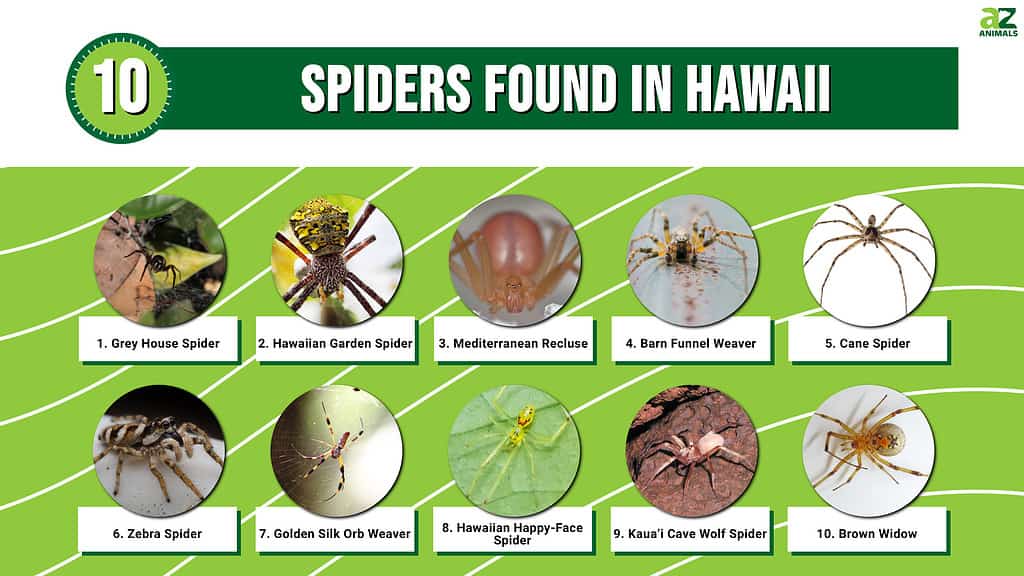
Hawaii is a land full of natural wonders. From their beautiful beaches to majestic mountains, the islands of Hawaii are home to several unique environments. Many rare and strange animals can be found in Hawaii, from color-changing chameleons to snake-eating mongooses. Hawaii is also home to many common and unique species of spiders. Here is a list of 10 spiders in Hawaii that you may encounter during your next foray around these magnificent islands.
#10. Brown Widow

The ventral side of the Brown Widow spider shows the hourglass pattern on the abdomen.
©Decha Thapanya/Shutterstock.com
Also known as the brown button spider or house button spider, the brown widow belongs to the cobweb spider family Theridiidae. It can be found throughout the world, although scientists estimate that its origins lie somewhere in South Africa.
Brown widows often get confused for black widows, although they possess a few notable physical differences. They typically appear tan or dark brown or black, and, like black widows, feature an hourglass-shaped marking on their abdomens. However, unlike black widows, their hourglass marking appears bright orange or yellow rather than red. Females measure 7 to 10 millimeters long, while males measure between 2 and 4 millimeters in length.
Despite their fearsome reputation, brown widows are not among the most dangerous spiders in Hawaii. In fact, although their bite can be quite painful, it is not considered medically significant. This is largely due to the fact that they do not carry as much venom as black widows.
#9. Kaua’i Cave Wolf Spider

Kaua’i cave wolf spiders are found only in the caves of Kaua’i.
©Gordon Smith / This image or recording is the work of a U.S. Fish and Wildlife Service employee, taken or made as part of that person’s official duties. As a work of the U.S. federal government, the image is in the public domain. For more information, see the Fish and Wildlife Service copyright policy. – License
Also known as the blind spider by locals, the Kaua’i cave wolf spider is the sole species in the genus Adelocosa. First discovered in 1973, it is one of the rarest spiders in Hawaii. This endangered species is found only in a few caves in the region of Kaua’i, and only a handful of populations have been discovered by scientists.
Kaua’i cave wolf spiders can grow up to 20 millimeters in length and appear reddish-brown in color. Unlike other wolf spiders, they produce a relatively small number of eggs, with only 15 to 30 eggs per clutch. Additionally, while other wolf spiders have 8 eyes, Kaua’i cave wolf spiders have none.
Since they live their lives underground, they evolved specialized hairs to detect prey by smell. They prey predominantly on a small species of cave crustacean, the Kaua’i cave amphipod, and their bite poses no threat to humans.
#8. Hawaiian Happy-Face Spider
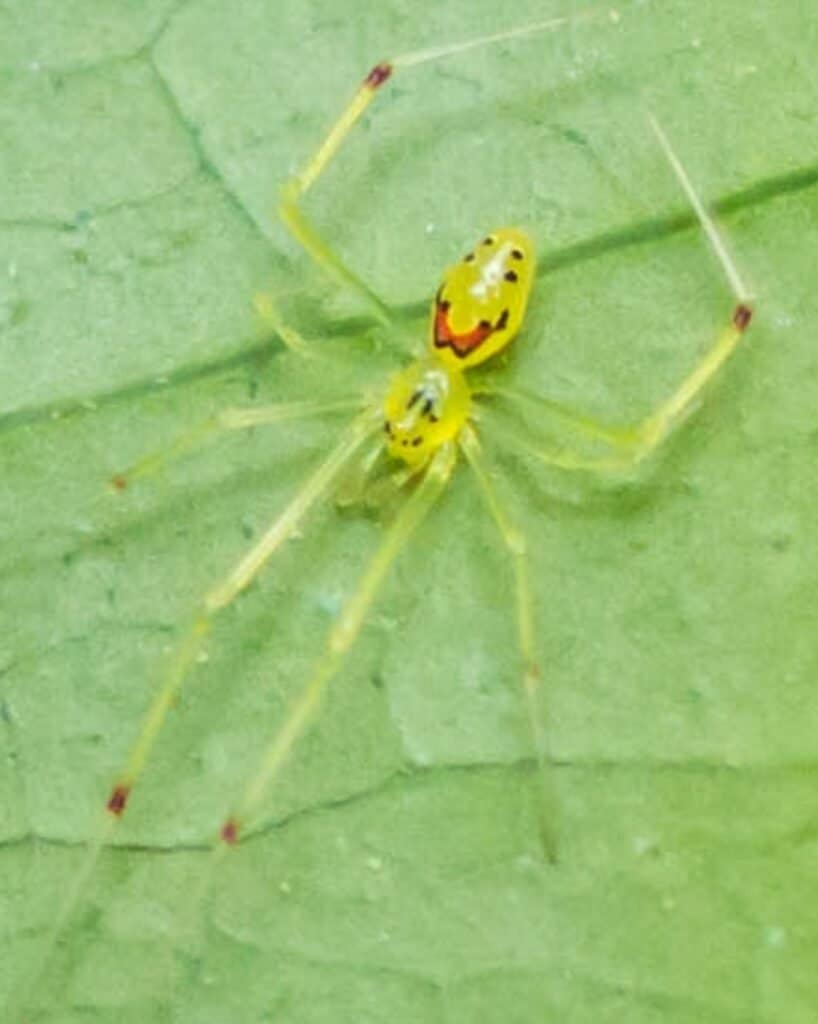
The Hawaiian happy-face spider gets its name from the smiley-face marking on its abdomen.
©Melissa McMasters from Memphis, TN, United States / Creative Commons – License
The Hawaiian happy-face spider is a member of the cobweb spider family Theridiidae. It is native to the Hawaiian islands and resides mostly in forests with high amounts of rainfall.
Hawaiian happy-face spiders get their name from the distinctive marking on their abdomens that looks like a human smiling face. They are a small species, with most specimens measuring only around 5 millimeters long. Their bodies are long and slender and appear almost translucent. They come in a wide variety of colors, including yellow, red, white, or black.
Interestingly, Hawaiian happy-face spiders can change colors depending on the food they eye. They actively forage for food and will occasionally use their silk as a net to capture prey. Their bite is not considered dangerous to humans.
#7. Golden Silk Orb Weaver
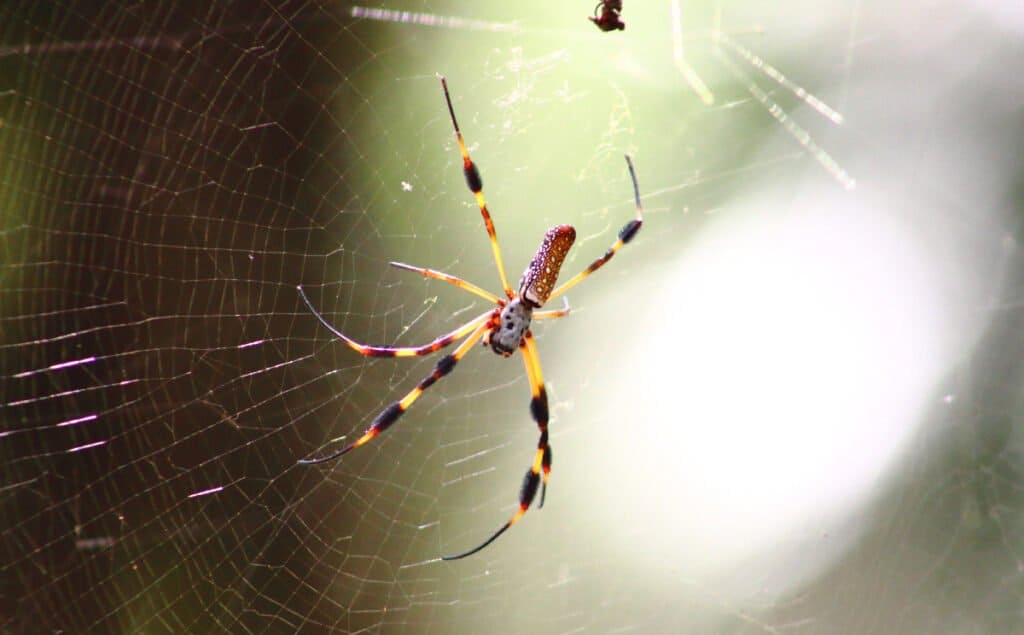
The golden silk
orb weaver
builds a web that measures nearly 5 feet in diameter.
©Max Rossa/Shutterstock.com
The golden silk orb weaver is one of the most misunderstood spiders in Hawaii. Also known as the banana spider due to the color and shape of its abdomen, it is often confused for the more aggressive Brazilian banana spider. However, the two do not belong to the same species, and the golden silk orb weaver is not as aggressive as its southern cousin.
Female golden silk orb weavers usually measure between 4.8 to 5.1 centimeters long, while males measure significantly smaller than females. They possess long, banana-shaped abdomens that appear golden or yellow in color and gold and brown striped legs. Their abdomens have white dots running down their length, while the sides contain white dashes.
Golden silk orb weavers build large webs measuring nearly 5 feet in diameter. They hang upside down from the yellowish-gold silk waiting for prey. Their bite is not considered medically significant.
#6. Zebra Spider
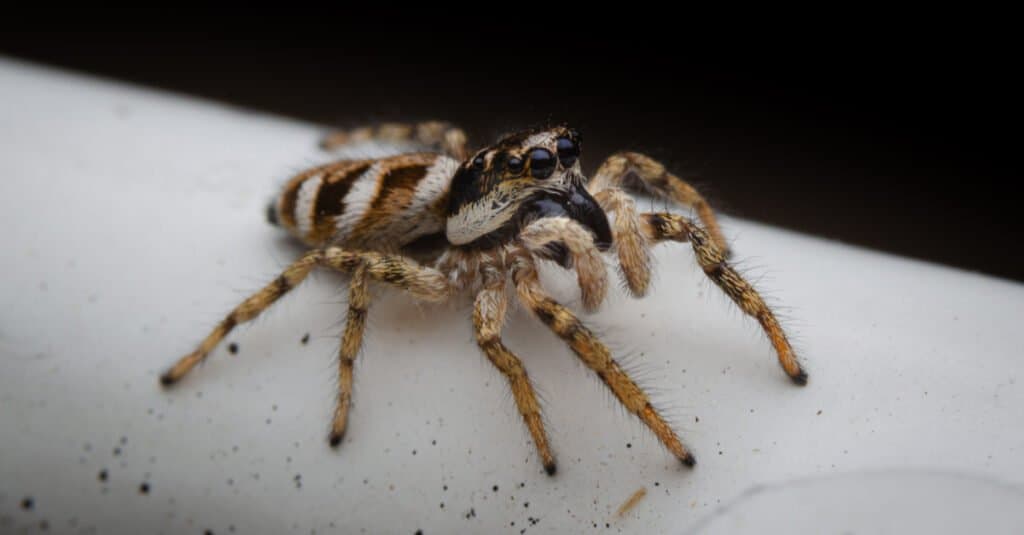
The zebra black spider has excellent binocular vision.
©Mario.Pieper/Shutterstock.com
The zebra spider, Salticus scenicus, is a member of the jumping spider family Salticidae. In Greek, its name translates to “theatrical dancing,” which refers both to its behavior and appearance. It is one of the most visually appealing spiders in Hawaii, thanks to its appearance and agility.
Female jumping spiders measure around 8 to 15 millimeters long and males measure around 6 to 13 millimeters long. Like other jumping spiders, they possess extremely large eyes and mouthparts. As their name implies, they sport black and white stripes across their bodies that resemble the stripes on zebras.
Zebra spiders use their keen eyesight and jumping ability to catch small insects and other spiders. You can often find them outside on plants or fences or inside on walls or window sills as they wander in search of prey. Due to their size, their bite is usually not able to pierce human skin.
#5. Cane Spider
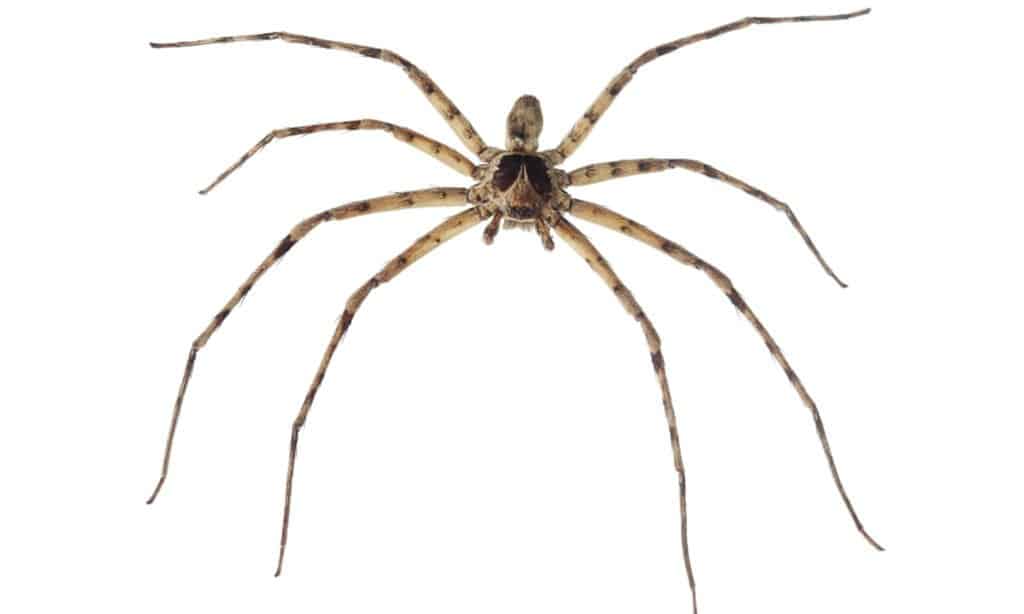
The cane spider is one of the largest spiders in Hawaii.
©foto76/Shutterstock.com
The cane spider is one of the largest spiders in Hawaii. Found throughout many subtropical regions of the world, it also goes by the name giant crab spider. It is a member of the huntsman spider family Sparassidae.
Most adult cane spiders measure between 20 and 25 millimeters long, with females measuring slightly larger than males. That said, males typically have longer legs. Overall, they appear mostly light brown or tan with dull black markings. However, the area in front of their eyes appears cream or yellow, and they sport a tan or cream band along their carapace.
Like other huntsman spiders, cane spiders hunt by running down their prey instead of catching them in webs. In addition to insects, larger specimens will also prey on scorpions and bats. Although their bite is not considered dangerous to humans, it can still be painful due to their large size.
#4. Barn Funnel Weaver
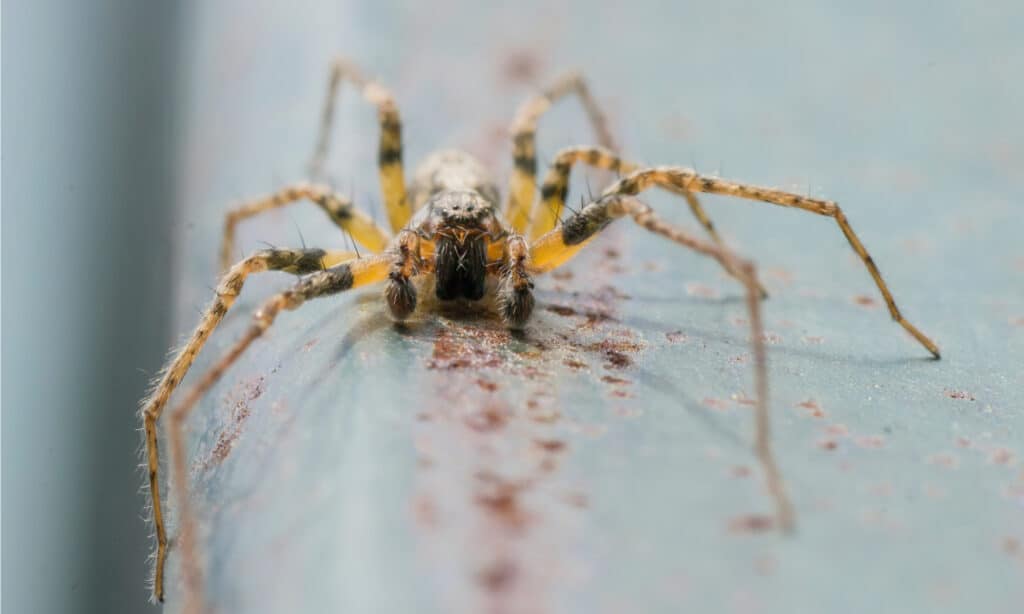
The barn funnel weaver is one of the most common spiders in Hawaii.
©Korovko Gleb/Shutterstock.com
The barn funnel weaver is a member of the funnel-web family Agelenidae. Also known as the domestic house spider in Europe, it is widely distributed throughout the world and is one of the most common spiders in Hawaii.
Barn funnel weavers possess elongated, flattened bodies and a relatively proportional leg/body ratio. Females typically measure between 7.5 and 11.5 millimeters long and males measure from 6 to 9 millimeters long. They usually appear dark orange, brown, or beige, and possess dull black stripes down their cephalothorax. Meanwhile, their abdomens feature brown, beige, or grey mottling.
As their name implies, barn funnel weavers build funnel-shaped webs that they use to capture prey. They wait at the back of the funnel shape until prey stumbles inside and then rush forward to capture and subdue their meal. Barn funnel weavers often flee from light and rarely act aggressively toward humans.
#3. Mediterranean Recluse

Mediterranean recluses originally hail from the Mediterranean but can now be found throughout the world.
©Malpolon/Shutterstock.com
Loxosceles rufescens, or the Mediterranean recluse spider, is one of the most invasive spiders in Hawaii. Originally hailing from the Mediterranean, it is now found throughout many parts of the world.
In terms of appearance, Mediterranean recluses appear almost exactly like the more commonly known brown recluse. Like brown recluses, Mediterranean recluses feature a violin-shaped marking on their cephalothorax. Both females and males measure around 7-7.5 millimeters long and appear mostly light or dark brown.
Just like other members in the genus Loxosceles, Mediterranean recluses possess powerful venom capable of causing skin necrosis. While usually medically insignificant, their bite causes pain, swelling, and redness, and may damage the skin. In some rare circumstances, bites may rupture blood cells, cause blood clots, or lead to renal failure, and even death. That said, this usually only occurs in very young or immunocompromised individuals.
#2. Hawaiian Garden Spider

Hawaii garden spiders often live in multigenerational communities that share web anchor lines.
©Arik.wib/Shutterstock.com
Argiope appensa, or the Hawaiian garden spider, is another orb weaver to make our list of spiders in Hawaii. While native to Taiwan and Guam, it lives on all the Hawaiian islands as well as New Guinea, Indonesia, and Australia. You can find it in various environments including forests, coastal habitats, and urban areas.
Including their legs, female Hawaiian garden spiders measure between 5.1 and 6.4 centimeters long. Meanwhile, males don’t even reach half the size of the females, and often measure nearly 4 times as small. Their abdomens appear bright yellow and are covered in black markings, while the legs contain black and yellow bands.
Hawaiian garden spiders often live in multigenerational communities with their webs placed close together. You can usually find their webs strung between branches in bushes or on buildings. Despite their large size, their bite is not considered threatening to humans.
#1. Grey House Spider
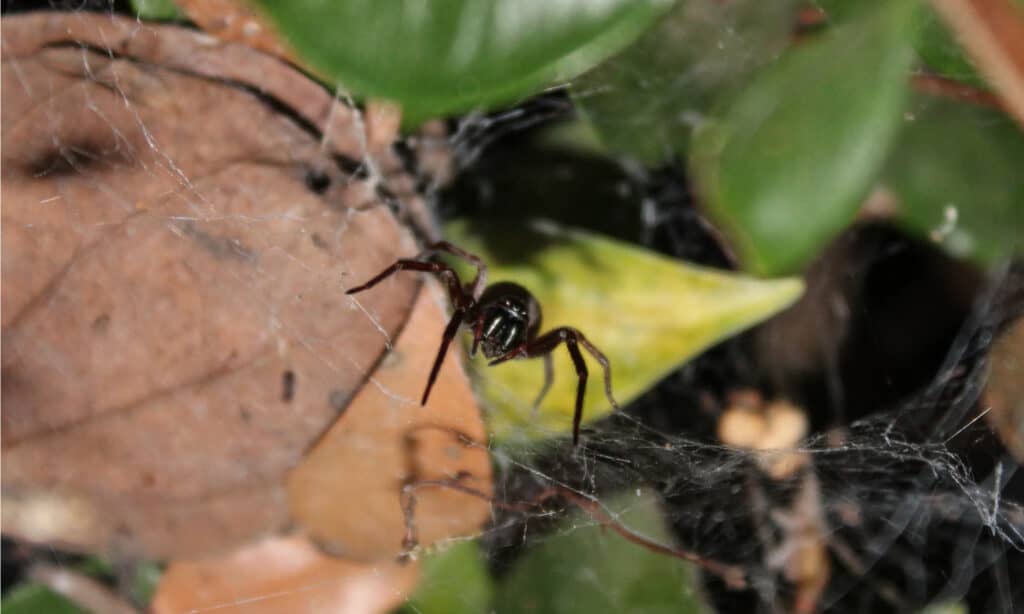
The grey house spider often builds its ladder shaped-web in cracks or crevices inside homes.
©Cassandra Madsen/Shutterstock.com
The grey house spider is a member of the intertidal spider family Desidae. While originally native to Australia, you can also find these spiders in Hawaii, New Zealand, Japan, Mexico, and Uruguay.
Female grey house spiders measure up to 14 millimeters long, while males measure around 10 millimeters in length. Their bodies appear light grey and feature numerous black markings, while their legs look purplish-brown.
Intertidal spiders get their name from the fact that they live in marine environments, typically in barnacle shells which they seal with silk. Meanwhile, grey house spiders often spin their webs in crevices or cracks inside homes. They wait for prey to fall into their ladder-shaped webs and then inject their target with venom, liquifying their bodies. While they are venomous, their bite poses little threat to humans.
Summary Of The 10 Spiders Found In Hawaii
| Rank | Spider |
|---|---|
| 10 | Brown Widow |
| 9 | Kaua’i Cave Wolf Spider |
| 8 | Hawaiian Happy-Face Spider |
| 7 | Golden Silk Orb Weaver |
| 6 | Zebra Spider |
| 5 | Cane Spider |
| 4 | Barn Funnel Weaver |
| 3 | Mediterranean Recluse |
| 2 | Hawaiian Garden Spider |
| 1 | Grey House Spider |
The photo featured at the top of this post is © Arik.wib/Shutterstock.com
Thank you for reading! Have some feedback for us? Contact the AZ Animals editorial team.






